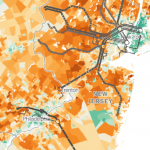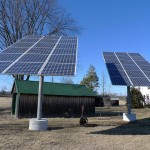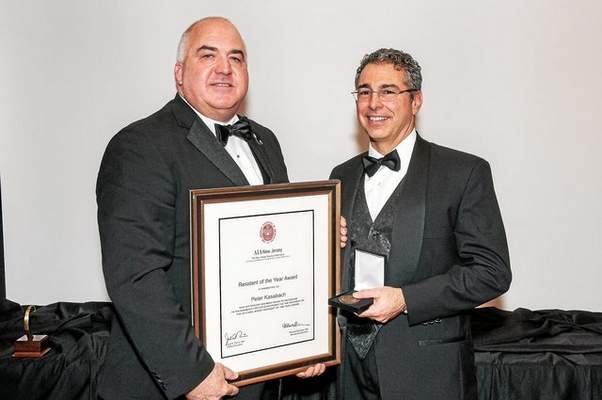New Jersey Future Blog
The ‘Shadow Northeast Corridor’ Draws Warehouses … and People
October 4th, 2011 by Tim Evans
An article on GlobeSt.com describes a recent meeting sponsored by NAIOP NJ where one of the speakers, Alex Klatskin, partner of Teterboro-based Forsgate Industrial Partners, made an astute observation: “The real beltway [around New York City] is not Interstate 287,” he said. “It’s 81 to 84.”
What he’s talking about is something that might be called the “Shadow” Northeast Corridor — a phenomenon that has been emerging recently in data on commuting and on county-to-county migration. It seems that the actual Northeast Corridor has gotten so densely populated, pushing land values so correspondingly high, that it no longer makes economic sense for the warehousing and distribution industry to build large-floorplan facilities there. It’s more cost-effective to build them on the periphery, where land is cheaper, and then truck goods in to their final consumption destinations in the actual Corridor. This is why so many new warehouses have sprung up along I-78 at the western end of the Lehigh Valley in Pennsylvania, and why you see so many of them along I-81 throughout the Mid-Atlantic states.
The movement of the goods distribution industry into these peripheral metro areas (Danbury in Connecticut; Kingston and Poughkeepsie-Newburgh in New York; Scranton-Wilkes-Barre, Allentown-Bethlehem, Reading, Harrisburg and York in Pennsylvania; Hagerstown in Maryland; Martinsburg in West Virginia and Winchester and Harrisonburg in Virginia) is having the odd effect that many of these counties are actually experiencing net domestic in-migration (that is, the number of people moving in from other counties exceeds the number moving out to other counties), despite hosting some aging industrial cities that have definitely seen better days. It appears that those aging Rust Belt cities that are fortunate enough to lie within 100 miles or so of Interstate 95 — many of which had been given up for dead — might yet find new life as outlying service centers and staging areas for the economic colossus of the Northeast Corridor.
These peripheral metros are also becoming the new frontier of commuting into the outer suburbs of the big Northeast Corridor cities, commuting that is facilitated by the same interstate highways that make these smaller cities attractive locations for the warehousing industry. Just as astronomical home values have pushed San Francisco Bay Area commuters out into California’s Central Valley — with cities like Modesto, Tracy and Stockton now sending substantial numbers of workers to the East Bay — the East Coast is seeing a similar phenomenon. As housing supplies in the major Northeast Corridor metro areas fail to keep pace with demand, middle-class households are seeking cheaper housing in peripheral metros. Bethlehem, Pa., is becoming an extension of the North Jersey suburbs of New York; Reading and Lancaster are becoming suburban Philadelphia; York, Pa., is becoming suburban Baltimore; and Hagerstown, Md., and Martinsburg, W. Va., are becoming suburban Washington, D.C.
All of these commuters fleeing to the periphery of the Northeast Corridor in search of more affordable housing — like the trucks issuing forth from warehouses seeking lower land costs — are driving back into the Corridor metro areas every day, adding congestion to our roads and pollution and greenhouse gases to our air. New Jersey and other states hosting the major urban areas of the Northeast Corridor should be looking for ways to expand housing options closer to employment centers, as well as ways to foster those employment nodes at transit-accessible locations, so that workers won’t be forced to travel Bay Area-style long distances to work every day, alone in their cars. They should also be attentive to the particular locational needs of the goods-distribution industries, so that land ideally suited for a new warehousing or transloading facility is not instead pre-empted by other uses, like housing or shopping centers, that could just as easily locate somewhere else. Finding room to accommodate more housing and more shipping facilities in the already-crowded Northeast Corridor may be challenging, but so, too, will be finding room to accommodate the resulting cars and trucks on our highways if we simply choose to export our space problem to the “Shadow” Northeast Corridor.


















This is very fascinating and somewhat bothersome information however I take some exception with the notion that it would be difficult to find space for warehousing and housing as a number of New Jersey cities remain essentially half-empty from their historic highs. Why didn’t anyone at NJ Future point this out?
Philly and a number of surrounding older PA towns remain far from their max potential as well.
Good food for thought Mr. Evans – as usual!
It seems to me that if NJ doesn’t do better in its thinking on affordable housing and comprehensive planning surrounding job growth and infrastructure we will lose out to PA and growth will continue its march in the wrong direction.
Not a good trend.
Planning and Zoning are the reason for the flight of growth – they cause the high prices by making land scarce – they are the enemy of the environment because they prohibit design by creating rules for design – but design is intrinsically inventive and invention breaks rules – they must be abolished if we are to save our planet.
We are progressing backwards – first we should design; then make the rules to fulfill that design – making rules for design is like making an omelet without breaking eggs – we are pissing up a rope.
This is a very interesting article and concept of the real outer beltway, which I had not thought of before. It makes a lot of sense. Tim, a good article. Here are some possible options I came up with to keep some of the warehousing in NJ, so we can keep some of the benefits of the jobs, link to urban centers with their workforce, and still be viable. Some of these are a bit radical, but given the state of the economy and probable low growth rates in jobs for a while, maybe its time for some different solutions.
1. Use some of our brownfield sites, as warehousing with incentives. These sites do not have to be cleaned up to the same standard as residential or retail, or office. Some of the landfills in the Meadowlands, Kearny, East Brunswick are examples. In addition, greenfield sites at Turnpike Interchange 7, 7A, and with the completion of the PA Turnpike/I-95 interchange, Rt. 130 in some parts.
2. Consider buy out of some of the residential lands that flood so much (Manville, parts of Wayne come to mind) and allow some to be open space, some to be warehousing. Both of these towns are near Interstate highways a bit further out, so they have access for trucks, but these sites can still be linked with urban centers that have a need for access for jobs without higher ed degrees etc. Obviously the warehouses may need to be elevated a bit. Both sites also have rail access, especially Manville.
3. Given the amount of vacant office space in NJ in some corridors (I-287 comes to mind), maybe some of that office space needs to be converted, or maybe its mixed with residential (always a tough sell, but maybe that is linked with incentives for conversion of office space to warehouse/housing).
Tim,
I like your other ideas but you would see more of New Jersey’s world-class agricultural soils stripped and paved over for more warehousing at Exits 7 and 7A?!?! It is already a crime against New Jersey’s 350yo agricultural heritage that in just the past 30 years, thousands of New Jersey’s (and the world’s) most productive agricultural lands were lost to warehouses and age restricted housing at Exit 8A.
How will we feed New Jersey’s and the region’s massive population in a post-oil world (when all these warehouses will be empty and useless anyway)? I’d like to keep as many options open as possible and maintain tangible and functional connection to New Jersey’s past (and future) as the “Garden State” .